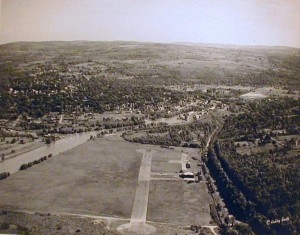Here is Part One of our Multi-Part Series on the History of Aviation in Ithaca, NY. We’ll see how it is received. It is exciting for us to use material we gathered years ago, when we used to spend a lot of time in Ithaca. Some of the material we had scanned already, and some is sitting in boxes, waiting to be found. Thanks go to the late C. Hadley Smith, the noted Ithaca-based photographer, and all rights are reserved. We look forward to your comments.
In 1944, the Ithaca Chamber of Commerce produced a report showing the need for commercial air transportation, reporting the following items were manufactured in Ithaca: adding machines, precision machine tools, novelty pottery, rock salt, technical mirrors, detergents, custom shirts, refined salt, shot guns, handbags, gauges, drive chains, Portland cement, paper, tools, and machine parts.
Ithaca had the largest number of telephones per capita of any city in the state of New York then, and it consistently ranked second or third in the state in volume of retail business per capita. The offices of the Grange League Federation, the largest farmer’s cooperative in the Northeastern U.S. at the time were in Ithaca, as were the offices of the New York State, Electric and Gas Corporation.
The principal railroad at the time, the Lehigh Valley, served New York to Buffalo, and intermediate points along its line. An average of 250 people traveled on it from Ithaca daily, not counting periodic special trains and increased loads during university breaks. This service left points such as Syracuse, and all points north and east from Syracuse and Harrisburg and Pittsburgh and points south and southwest without railroad connection. Individuals bound for Syracuse took the bus. An average of 1320 people a week took the bus each way, many of them making connections with the railroad. Before World War II, Ithaca produced the largest dollar volume of bus traffic per capita of any city east of the Rocky Mountains.
While this was the environment in which the current airport was built, the truth was that Ithaca had already had an airport for years. In 1913, the Thomas School of Aviation took over a flat tract of land near the Inlet at the south end of Cayuga lake which had been rented to a peach grower. Some of the peach trees were cut for a runway, and a storage hangar was constructed. They initially operated pusher hydroplanes into the lake, and switched to landplanes. Thomas-Morse Aviation, based on South Hill, produced airplanes. Ithaca, for this, and many other reasons, has a long standing history of pioneering aviation. In fact, Ithaca dispatched the first airmail in the United States on October 14, 1916 according to our research.

In 1928, H.M. Peters was appointed airport manager by the city of Ithaca, after the departure of Thomas-Morse, which had rendered the airport mostly unused. Peters had joined the military to learn to fly when his proximity to the aviation companies of Ithaca sparked a life-long love of flying. The job as manager paid little, so he established the Ithaca Flying Service, doing charter and air taxi flying, the first commercial air service out of Ithaca.
During the depression, when there was little funding for such projects, Peters and the city of Ithaca somehow secured WPA funds and constructed the first paved runway in Central New York at the Ithaca Municipal Airport, as well as a two-story glass, steel, and stone hangar, used today as the Hangar Theatre, one of several small theaters in the town.
To Be Continued…. Comment or Twitter if you find this of interest.
![Reblog this post [with Zemanta]](http://img.zemanta.com/reblog_e.png?x-id=99ff4b02-80a6-475f-90ba-83e16a401636)